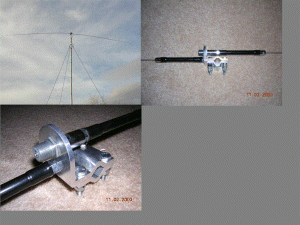Glendora Emergency Response Communications
Antenna Tips - The Francis Amazer RTD

Novel Field Day HF Dipole Antenna
by Mark Hayden, KF6DSA
Most EMCOMM hams are always looking for that “perfect” directional HF antenna, one that is easy and fast to set up, yet one that will definitely get good results and is rotatable. If the antenna is fairly inexpensive, so much the better.
Kurt Rudolph, KD7JYK, who hails from Dayton Nevada, has been using a simple rotatable HF dipole antenna he made from two CB whips for many years, and has made contacts all over the globe. He developed a custom mounting bracket that is able to withstand the severe seasonal weather conditions that prevail there, which include winds approaching hurricane velocity. “The RTD bracket I use is very rugged, it is 2x2 aluminum angle 1/4" thick and about 7" long. I use two 1/4" stainless saddle bolts with stainless hardware to secure it on my mast.”
Kurt sent me a bracket he made from a CB antenna mirror mount that he drilled and tapped for the counterpoise so I could try his antenna design at Field Day 2004. (See photo) I first tried two 102 inch stainless steel CB whips from the swap meet but the horizontal position caused them to droop about 2 ½ feet! The solution was to use 96 inch fiberglass whips, known as Francis Amazers. These whips, commonly used on big rig trucks, are much more rigid and somewhat lighter than stainless steel, they drooped only a few inches. I affectionately named my antenna the” RTDipole or RTD” after Kurt’s company, Ross-Technologies. I next attached the antenna to a 20 foot mast to test it.
Using an antenna analyzer, I found that the antenna array was resonant at 26.77 Mhz, not surprising since the whips were meant for CB. However, by using a MFJ945E antenna tuner I was able to get a 1:1 SWR on 10, 15, 20, and 40 meters! We were ready for Field Day!
Field Day - Did Francis Amaze Us?
We assembled our antenna on a 20 foot mast in the parking lot of the local church where our Field Day was to be held, carefully connected the 50 ohm coax and hooked up to the tuner and radio, a Kenwood TS 140S. I was concerned that our urban location and low elevation might prevent this antenna from performing at all.
We carefully tuned the rig to the recommended middle of the 20 meter band and set the transmitter to full power of 100 watts. About then Field Day officially commenced!
Wow! The airways exploded with CQ Field day! CQ Field Day! British Columbia! Next came contacts to Western Washington, Montana then Minnesota! The RTD antenna worked big time!
Since I was also the Field Day event coordinator, I only could spend a few hours on the air myself, but the log says contacts were made from Western Washington to New Hampshire and many states in between. Not bad for a converted CB antenna! We later tried the 15 meter band with equal success, exchanging information with stations in Georgia and Alabama.
How to Build Your Own RTD
The RTD antenna can be built (really a no-brainer) for under $50, and finding some good deals at a swap meet may cut that price considerably. Most CB shops near truck stops carry the Francis Amazers, which are about $15 each. The aluminum bracket pre-drilled for the dipole arrangement is available commercially for around $14, but it is a simple matter to drill and tap the counterpoise hole in a regular CB mirror bracket using a 3/8 inch tap, thus saving $5 to $7. You may need to get longer ¼ inch bolts for your mast than come with the bracket.
Ascribing to the “K.I.S.S.” philosophy, the RTD antenna performs beyond what one would expect!
73 DE KF6DSA
Email us
cloudtracker@aol.com


